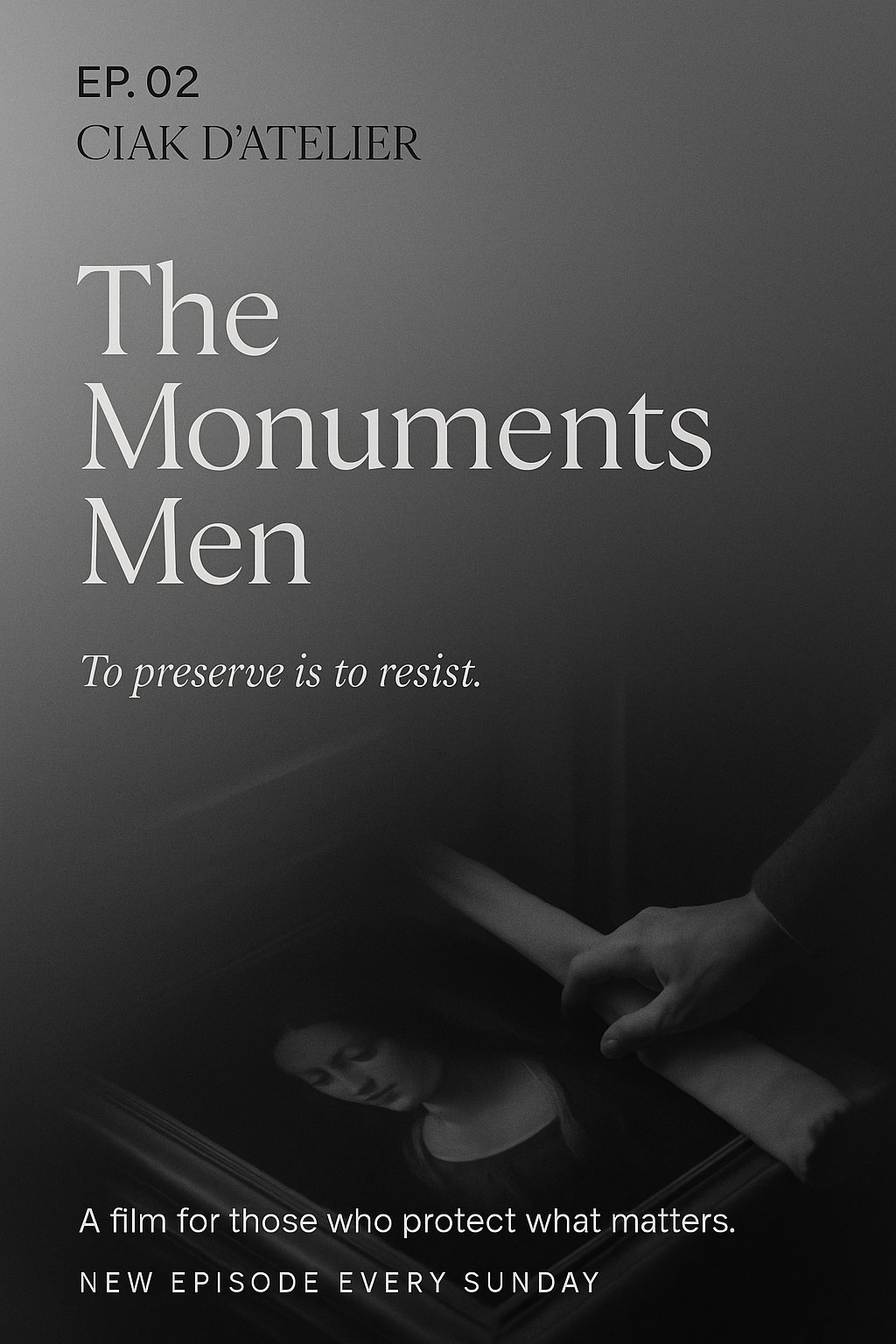The Monuments Men
Not just a reflection on a film, but a heartfelt invocation of care, memory, and resistance. Through the silent courage of forgotten figures like George L. Stout and Rose Valland, it reminds us that art is not matter, but meaning. A living legacy connects past and present, calling each of us to become guardians of beauty in a world at risk of forgetting.
CIACK D'ATELIER
Charlotte Madeleine Castelli
6/22/20254 min read


The Echo of the Soul and the Silent Heroes
The Monuments Men.
A flame burns silent, stubborn. Among the ruins, a whispered truth, often overlooked, runs through The Monuments Men like a golden thread beneath the surface of an ancient canvas: art, in all its infinite forms, is never mere matter, it is testimony, flesh of time. What this film offers back to us, measured and quietly resolute, is the profound meaning of care. Not just care for objects, but for the invisible legacy that flows between generations. This is not an action story disguised as a historical film, but rather an elegy for those who chose, in the very midst of war, to save what could not be allowed to die.
Within the folds of the narrative, we glimpse the true faces of men like George L. Stout, restorer and conservator at Harvard's Fogg Museum, who inspired the character played by Clooney. He was among the first to envision a unit for protecting art in war zones, years before the Normandy landings. He also laid the groundwork for many of the preventative conservation methods still in use today. He was a man of action, yes—but also of thought, having written deeply on the notion of stewardship as an ethical responsibility. And like him, many other names now forgotten walked through the shadows to restore light to what was at risk of fading.
Few remember the vital role of Rose Valland, the French art historian (on whom Cate Blanchett’s character is based) who worked at the Musée du Jeu de Paume, under Nazi control. She was not only a lone woman among men, but an undercover agent with no official protection, who risked her life daily to meticulously document the destinations of looted works. For years she pretended indifference, though she spoke fluent German and used that silent weapon (observation) to trace a map of a plundered continent. Thanks to her records, thousands of masterpieces were recovered after the war.
What this 2014 film quietly proposes, if you’re really listening, is that culture can be a revolutionary gesture. That there exists a form of heroism needing no fanfare: a courage made of silence, of stubborn gestures, of unwavering belief in beauty when all around screams destruction. It’s a subtle reflection that asks us: what are the monuments we must protect today? What are we losing in the noise of everyday life, in the rise of digital totalitarianisms, in the slow erosion of depth and thought?
The film, deliberately restrained and at times held back, does not indulge in spectacularization. It remains faithful to the tone of those who handle time and memory with respect. It doesn’t merely show the fight to retrieve works like Michelangelo’s Madonna of Bruges or the Ghent Altarpiece, but suggests a deeper disquiet. Who are we, if we forget? Who do we remain, if our roots are cut?
There is no rhetoric in these men and women, only the clear awareness that by saving a work of art, they were saving a world. And even when they faltered or failed, what remained was a luminous conviction that shapes the rarest form of beauty: devotion.
As a curator and a lover of art, I am drawn to this idea of curating as an ethical, political, and profoundly human gesture. It’s not enough to preserve an object, we must keep it alive, allow it to speak, question it, and defend it. The work of every conservator, every archivist, every researcher who spends hours in the dark of a climate-controlled room tracing a pigment or a hidden signature, is part of the same invisible thread that ties their efforts to those of the Monuments Men.
And today? That unit still exists reborn as the Monuments Men and Women Foundation. It is actively promoting research and justice in the recovery of art still missing. This reminds us that this is not a closed chapter, but an ongoing mission. And perhaps that is the film’s most subtle message: every viewer is, in some way, invited to become a Monuments Man or Woman. Each of us, in our own way, can choose to be a custodian of memory, of story, of beauty.
The Monuments Men is therefore a declaration of love and resistance, an invocation of care, a plea not to look away, but rather to recognize (beneath a dusty frame) the face of humanity that concerns us all.
Because in every fragment of beauty saved from oblivion, we rediscover (trembling, but more alive) a piece of our very soul.
And no, it does not end with the credits. What The Monuments Men recounts is not merely a past story, tucked away in archives and nostalgia, it is a living legacy, a torch still burning, carried forward today by the Monuments Men and Women Foundation: the institution founded to honor, continue, and make visible the often-overlooked work of these silent heroes.
The foundation, created through the vision of Robert M. Edsel (author of the book behind the film), works tirelessly to locate still-missing works of art, to support restitution efforts to rightful owners, and to nurture a sense of shared responsibility for cultural preservation among younger generations. It collaborates with museums, archives, universities, research bodies, and military institutions, offering scholarships, educational programs, and digital tools to map the massive archive of cultural devastation wrought during wartime. Its mission is as simple as it is titanic: to protect memory by building bridges between the past and the present.
And it is within this context, resonant and visionary, that the commitment of Future Maastricht Museum & Gallery also takes root. The institution I carry forward with passion and responsibility alongside Riccardo Perillo is not merely a museum, but an international curatorial platform: a cultural front line for a new form of artistic and archival activism.
The bond with the Monuments Men and Women Foundation is not just symbolic, it is tangible, operational: we share the same sense of urgency in treating cultural heritage as essential infrastructure for a conscious society, imagining future residencies, digital archives, curatorial training programs, and transdisciplinary reflection on themes of memory, restitution, and cultural justice.
We are convinced that art can no longer be merely contemplated: it must be protected, activated, re-circulated with awareness. And in doing so, we acknowledge the debt we owe to those who, seventy years ago, with nothing more than a torch in hand and a map hidden beneath their uniform, stepped into a bunker to rescue a painted face.
Because their gesture concerns us still. It reminds us that, amid the dull roar of a world in haste, there is still a need to hear the silent voice of beauty asking to be guarded. We carry their torch forward not as heroes, but as vigilant souls who believe in the indestructible force of memory and the urgent need to make it visible, alive, and necessary.
© Charlotte Madeleine Castelli | All rights reserved
